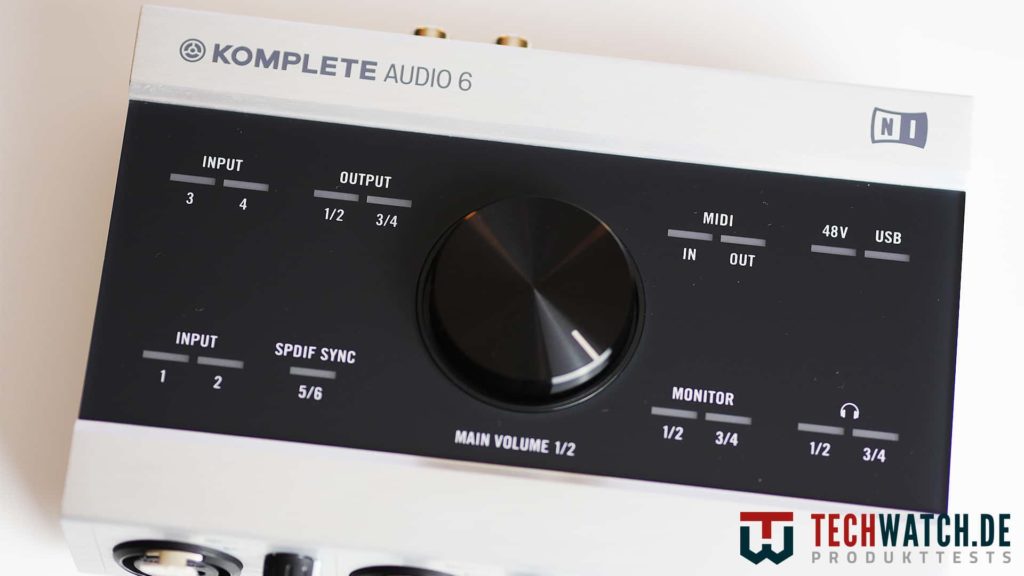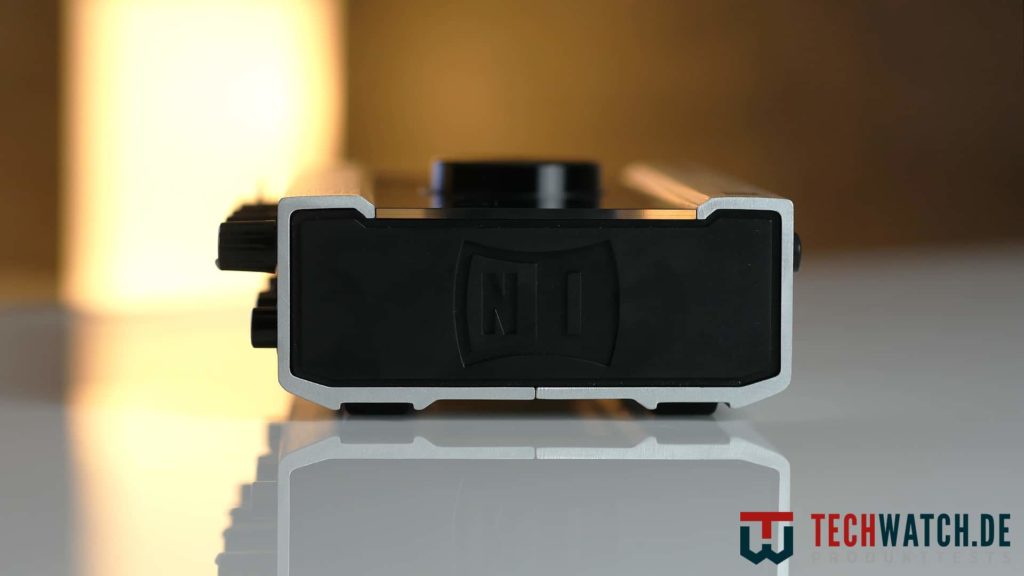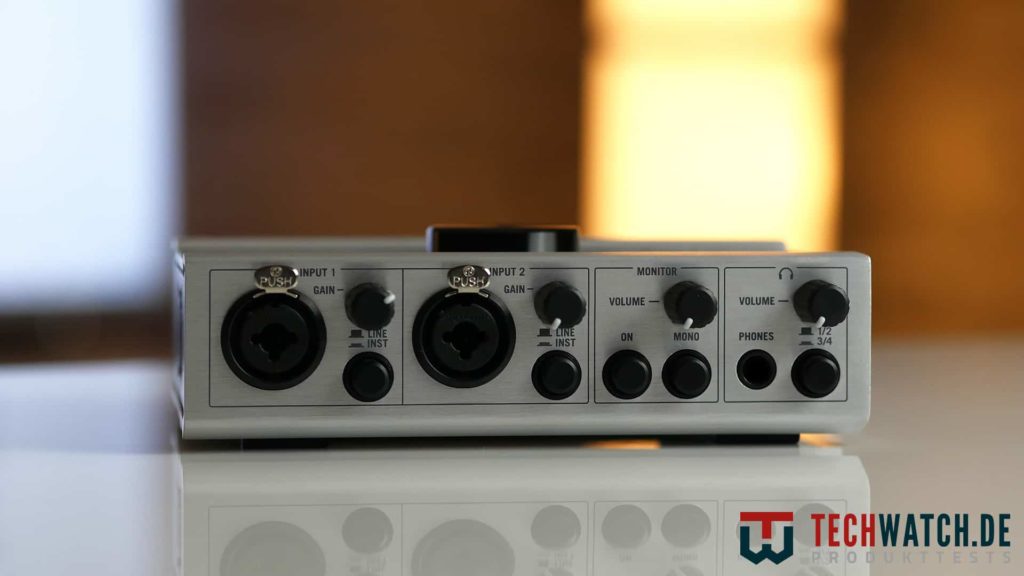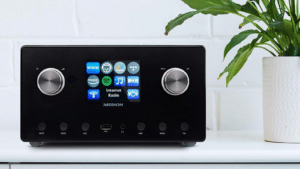The USB audio interface Komplete Audio 2011 from Native Instruments, which was released in 6, promises to be most expensive device in our test series premium audio quality and low latency. In our test in combination with the Condenser microphone Røde NT2A let's check to what extent this is true and whether NI stands up to the competition à la Focusrite Scarlett can prevail.
The NI Komplete Audio 6 convinces across the board with grandiose workmanship and modern design, excellent audio quality and many connections.
- Audio interface with low latency, flexible...
- Low latency values for virtual instruments and effects
- 4 analog I/O, digital I/O and MIDI I/O
Processing of the highest class
The Komplete Audio 6 consists of consistently high-quality materials. The front, back and bottom of the device are encased in brushed aluminum. A dark plexiglass strip was embedded at the top. The connections, rotary controls and buttons are extremely stable, sit securely and are easy to use. Unfortunately, while the aluminum largely retains its good looks, the black Plexiglas surface is an absolute dust magnet. So if you want to keep the great design, you have to grab a rag more often than we would like.
On the front of the audio interface there are two, separately controllable, symmetrical combination connections for XLR or 6,3mm jack plugs. Below that is the LINE or Instruments button to distinguish between sources with a high level (e.g. keyboards like the Komplete Kontrol S61 from Native Instruments) or low level (e.g. guitars). For our test scenario with a condenser microphone, however, these options are irrelevant because they are not used on XLR devices. Next to it is the volume control for monitoring (direct, latency-free pre-listening of the connected sources) and the button for switching between mono and stereo sources. On the right front is the 6,5mm jack for headphones and the associated volume wheel as well as the source selection.

On the back is the button for phantom power and the USB port, an input and output for MIDI controllers such as the Cubase sequencer, SPDIF input and output, the two main outputs for transmission to mixers or active speakers and 2 symmetrical 6,3 .XNUMXmm jack inputs and outputs.

On the top is the large volume control for the two main outputs as well as all sorts of status LEDs embedded behind a plexiglass pane. In addition to input and output displays with an integrated overload warning, the interface indicates active USB, MIDI and SPDIF connections as well as active phantom power. Activated monitoring and the selected sources are also displayed.
Phantom power is a type of microphone power supply. The DC voltage between 9V and 48V is supplied directly via the XLR cable, making rechargeable batteries or batteries obsolete.
Installing the Komplete Audio 6
Installing the Komplete Audio 6 is easy:
- Connect the interface to your PC using the supplied USB cable Mac.
- On a Windows PC, the current drivers must be loaded from the Native Instruments website. You find these here. Macs do not require drivers, but you can, regardless of the one used Platform update your device using Device Updater. After installation, the USB LED on the right corner of the Komplete Audio 6 should glow green.
- Now close yours Microphone with an XLR cable to one of the two front inputs of your interface.
- Activate the phantom power on the back of your audio interface. The corresponding LED should now light up orange.
- Turns the GAIN control of the selected input to the far left to prevent tinnitus.
- Now only the volume of the microphone has to be adjusted. To do this, the device must be monitored, either via the built-in monitoring function or via the operating system. In Windows, right-click on the speaker icon in the taskbar at the bottom right and select "Recording Devices". Selects in the list, depending on the selected input, for example "Inputs 1/2". Right click on it and select "Properties". Now select the second tab "eavesdropping" and click on the box "Use this device as playback source" to be able to hear the microphone through your default playback device. Now put in the tab "Level" Make sure that it is set to 100% and slowly turn the GAIN control of your input to the right until you can hear your voice loud and clear. The interface warns you of overloading if the setting is incorrect by the input LED lighting up orange. Do not forget to deactivate the playback again afterwards.
- Return to the Recording Devices menu, right click on the same input and select : "Set as default device" and "Select as default communication device".Complete! Your devices are now connected, leveled and ready to use for singing or voice recording, streaming or skyping.
Sound quality without restrictions
USB audio interfaces are often versatile devices that can be used for tons of tasks. The Komplete Audio 6 particularly stands out here with its large number of connections. In our sound test, we use the interface as a recording device for the Røde NT2A, which we will examine more closely in a separate test shortly.

In terms of sound quality, the Komplete Audio 6 can easily compete in the highest league of sound quality and is suitable for both studio and live setups. The reason for this are the high-quality Cirrus Logic converters that have been processed. The sound is powerful and clear and is one of the best in the product field. We can also confirm the promised low latency. At least in everyday use of the microphone, we could not detect any significant delay. This makes the interface ideal for recording sessions at a very high level.

| Preview | Products | ||
|---|---|---|---|

|
Native instruments... |
|
Buy now " |







